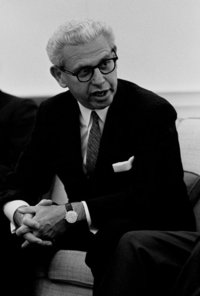Arthur Joseph Goldberg
|
|
Arthur Joseph Goldberg (August 8, 1908 – January 19, 1990) was an American statesman and jurist who served as the U.S. Secretary of Labor, Supreme Court Justice, and Ambassador to the United Nations.
| Contents |
Early Life
Goldberg was born and raised on the West Side of Chicago, the youngest of eight children of Russian immigrants. Goldberg's father, a produce peddler, died in 1916, forcing Goldberg's siblings to quit school and go to work to support the family. As the youngest child, Goldberg was allowed to continue school, graduating from high school at age 16.
Goldberg's interest in the law was sparked by the famous 1923 murder trial of Leopold and Loeb, wealthy young Chicagoans who were spared the death penalty with the help of their high-powered defense attorney, Clarence Darrow. Goldberg would later point to this case as inspiration for his opposition to the death penalty on the bench, as he saw how inequality of social status could lead to unfair application of the death penalty.
Goldberg earned a distinguished reputation as a student at Northwestern Law School, where he edited the law review, graduating in 1930.
Labor lawyer and Kennedy Administration
Goldberg became a prominent labor lawyer, representing striking Chicago newspaper workers on behalf of the CIO in 1938. He served in the Office of Strategic Services as a contact with the European underground labor movement during World War II. Appointed general counsel to the CIO in 1948, Goldberg served as a negotiator and chief legal advisor in the merger of the AFL and CIO in 1955.
Goldberg was by this time a prominent figure in the Democratic Party and in labor union politics. President Kennedy appointed Goldberg to two positions – first as Secretary of Labor, where he served from 1961-1962, and then as an associate justice of the Supreme Court, replacing Felix Frankfurter, who had resigned because of poor health.
Supreme Court
Despite his short tenure on the bench, Goldberg played a significant role in the Court's jurisprudence, as his liberal views on constitutional questions shifted the Court's balance toward a broader construction of constitutional rights. For example, he wrote an influential concurring opinion in the case of Griswold v. Connecticut (1965), arguing that the Ninth Amendment supported the existence of an unenumerated "right of privacy."
Perhaps Goldberg's most influential move on the Court involved the death penalty. Goldberg argued in a 1963 internal Supreme Court memorandum that imposition of the death penalty was condemned by the international community and should be regarded as "cruel and unusual punishment," in contravention of the Eighth Amendment. Goldberg was the first to argue this position: prior to Goldberg's memo, no Supreme Court case had addressed the question of whether the death penalty violated the Eighth Amendment. Finding support in this position from only one other justice William J. Brennan, Goldberg published an opinion dissenting from the Court's denial of certiorari in a case, Rudolph v. Alabama, involving the imposition of the death penalty for rape, in which Goldberg cited the fact that only 5 nations responded indicated on a United Nations survey that they allowed imposition of the death penalty for rape, including the U.S., and that 33 states in the U.S. have outlawed the practice.
Goldberg's dissent sent a signal to lawyers across the nation to challenge the constitutionality of capital punishment in appeals. As a result of the influx of appeals, the death penalty effectively ceased to exist in the United States for the remainder of the 1960s and 1970s, and the Supreme Court was forced to consider the issue in the 1972 case of Furman v. Georgia, where the Justices, in a 5-4 decision, struck down the death penalty laws of states across the country (the decision would be revisited in 1976's Gregg v. Georgia, where the justices voted to allow the death penalty under some circumstances). The death penalty for rape, however, would be struck down in 1977's Coker v. Georgia. Goldberg's mode of analysis, comparing the practices of other nations and states of the U.S., became a standard test used by the Court in evaluating Eighth Amendment claims.
Subsequent Career
In 1965, Goldberg was persuaded by President Johnson to resign his seat on the court to replace the late Adlai Stevenson as the US Ambassador to the United Nations. Goldberg accepted only after much prodding by Johnson, in the hope of negotiating a settlement to the escalating conflict in Vietnam. In that post, Goldberg clashed with Johnson over the course of the Vietnam War. Goldberg, frustrated with the war in Vietnam and longing to return to the bench, resigned from the ambassadorship in 1968. Goldberg was mentioned as a potential nominee for Chief Justice when Earl Warren announced his retirement in 1968, but was passed over in favor of Abe Fortas (whose nomination was eventually sucessfully filibustered).
In 1970, Goldberg ran for Governor of New York, but proved an underwhelming campaigner and was defeated decisively by incumbent Nelson Rockefeller. Subsequently, Goldberg returned to law practice in Washington, D.C., and served as President of the American Jewish Committee. Under President Jimmy Carter, Goldberg served as United States Ambassador to the Belgrade Conference on Human Rights in 1977, and was awarded the Presidential Medal of Freedom in 1978.
In 1931, Goldberg married art student Dorothy Kurgans. They had one daughter Barbara (Cramer) and a son, Robert.
Goldberg died in 1990. He is buried at Arlington National Cemetery.
| Preceded by: James P. Mitchell | United States Secretary of Labor January 21, 1961 – September 20, 1962 | Succeeded by: W. Willard Wirtz |
| Preceded by: Felix Frankfurter | Associate Justice of the Supreme Court of the United States October 1, 1962 – July 25, 1965 | Succeeded by: Abe Fortas |
| Preceded by: Adlai Stevenson | U.S. Ambassador to the U.N. 1965 – 1968 | Succeeded by: George W. Ball |

